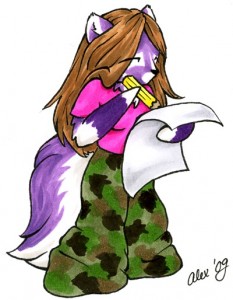Where Do the Fur and Tail Come In?
When furry writers start discussing furry fiction, two issues that seem to universally come up are what makes furry fiction, and what writing stories featuring anthropomorphic characters entails. In this entry I’m going to focus on the latter, and especially on physically anthropomorphic characters, as they are generally what is used in furry fandom.
One point that I’ve seen getting raised in practically every such discussion, is the idea that you should not include furry characters unless you have a good reason for it. If you can’t give a good reason why Susan is a wolf, you should just keep Susan as a human, without having fur, tail and ears stuck on. On the surface, this is a good, reasonable argument. In some circumstances, it holds water with the best of them, but in others, it’s honestly about as waterproof as the Titanic.
But that argument is forgetting one important point. And to illustrate that point, I’m going to tell you a story from my childhood.
When I was little, I had a friend who lived two houses over. She was 11 months older than I, and looking back I realize it probably wasn’t the most equal friendship, but at the time, well… kids are kids and not always the most insightful. But there’d be days when I just didn’t feel like playing with this friend, who could be very bossy and overbearing at times. She’d call and ask me to play, and I’d say “no”. So she’d ask why. I’d say “because”. And she’d say “because isn’t a real reason.”
She was wrong. “Because” is a perfectly adequate reason. I can write stories about bipedal foxes getting it on because I want to. You can write stories about anthropomorphic tigers because you like anthropomorphic tigers. It doesn’t have to go deeper than that.
Along with the idea that you need a deep reason to write about animal-people going about their day instead of about humans doing the same, goes the notion that you need to put deep thought into how a society of furries would have developed differently from ours. To some extent that may be a good idea, but when you get to the point of chairs and clothes appropriate for creatures with fur and a tail, you’re honestly forgetting another point: if this is a society where everyone has them, nobody’s going to reflect over how awesome it is that the chair has a gap for theil tail any more than you marvel over your shirt having holes for both your arms to come out.
The key, as in all world-building, is consistency. If you have an all-furry setting, and species influences the behavior of the dogs, it should influence the behavior of the cats, as well. There is no shame in writing where the furry components are little more than window dressing, as long as you’re aware that’s what you’re doing and do it for all your characters across the board. It is a lot more jarring to have a story full of characters which don’t act significantly different from humans and one labrador who compulsively chases cars and tennis balls, than it is to have a story of what I have seen described as “humans in fursuits”.
That said, if you have a setting which mixes humans and furries, it may be to your advantage to make sure there’s something other than the outside setting them apart, but what exactly this should be depends on your social setting. If there’s friction and distrust, chances are the differences will be greater than if everyone is living in harmony.
All you need to write furry fiction (as opposed to non-furry fiction — I’m sorry to say, if you can’t write, you can’t write) is the desire to write about anthropomorphic animals.
Further reading:
Academic essay about Colin Dann’s The Animals of Farthing Wood

Leave a Reply